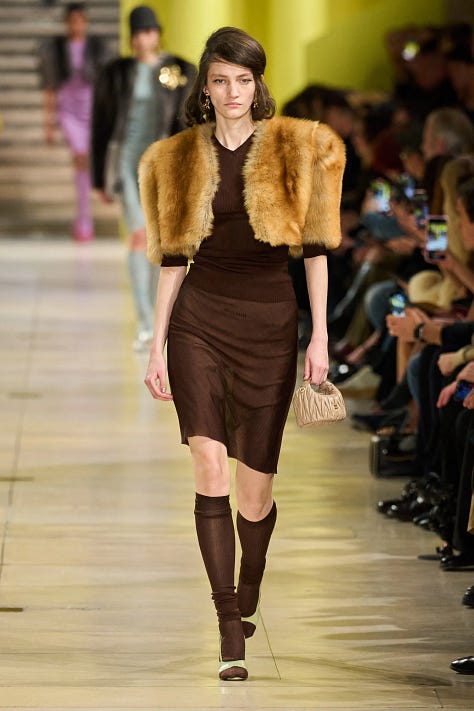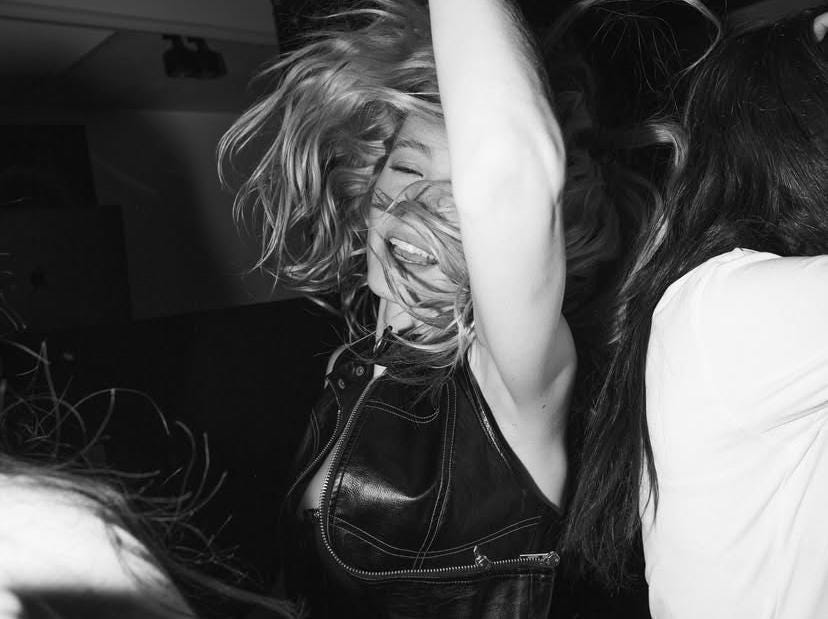Lately, I’ve been thinking about how my closet reflects the many versions of myself: some days it’s sheer tights, pointy heels, and oversized blazers, other days it’s slouchy boots and oversized jackets. That’s the beauty of being a 20-something; we’re not choosing one aesthetic, we’re building closets that reflect the full spectrum of who we are.
Samantha unpacks how cult-favorites Miu Miu and Isabel Marant have tapped into this energy, creating worlds where self-expression isn’t just welcomed, it’s expected. These aren’t just “it-girl” brands. They’re a blueprint for what modern luxury looks like when storytelling, identity, and intention take center stage.
Happy reading,
Amarissa

Sexy, bold, and effortlessly cool—Miu Miu and Isabel Marant have mastered the art of understated luxury, captivating the hearts of fashion-conscious 20-somethings with their balance of minimal branding and maximal impact.
Miu Miu was founded in 1993 by Miuccia Prada as the playful, rebellious younger sister to Prada—designed to capture the spirit of youth and adventure that still drives the brand’s success. Despite operating at a slightly higher price point, Miu Miu has stayed relevant, with significant growth in sales and brand awareness in recent years.
Similarly, Isabel Marant launched her namesake label in Paris in 1994, quickly gaining momentum for its effortless, cosmopolitan aesthetic, and, of course, the iconic Bekett sneaker. Today, Marant is trending once again across TikTok and Pinterest, thanks in part to the revival of early 2010s indie sleaze aesthetic. Both brands have cultivated cult followings through distinct design identities that deeply resonate with young, style-savvy audiences.
While many luxury brands are experiencing sluggish sales, Miu Miu and Isabel Marant continue to thrive—reporting growth throughout 2024 and even more traction this year. Founded just a year apart, the two brands have mirrored each other not only in popularity but also in customer appeal, both drawing in a younger, fashion-forward demographic. Their success lies in a potent mix of immersive marketing, thoughtful sustainability initiatives, and a clear, consistent brand identity.
In today’s landscape, legacy alone isn’t enough. Luxury houses can no longer rely on name recognition or lazy branding to keep Gen Z engaged. As this generation steps into real purchasing power, demanding relevance, responsibility, and authenticity, brands must evolve—or risk becoming obsolete.
While many of fashion’s biggest players, Gucci, Louis Vuitton, and others, grapple with sluggish sales across consecutive seasons, Miu Miu and Isabel Marant have cracked the code. According to a Bain & Company report, factors such as luxury price inflation, shrinking Gen Z loyalty, and persistent barriers in the Chinese market have contributed to the broader slowdown. Yet somehow, these two brands are thriving—meeting a younger, professional, and predominantly female audience exactly where they are.
What is it about Miu Miu and Isabel Marant that makes them so irresistible? What keeps their consumers hooked? And are the women driving their success two sides of the same coin—or part of entirely different fashion tribes?
Shoppers drawn to these brands aren’t chasing hype or flashy branding—they’re seeking innovation, thoughtful design, and strong brand storytelling. For them, clothing is a language. It’s about expressing, not impressing. These young adults aren’t looking to blend in, they’re curating wardrobes that reflect who they are and who they’re becoming. They’re open to influence, but not interested in imitation. They want pieces that will last—both stylistically and physically.
Ready-To-Wear Fall 2025
Models, influencers, buyers, and celebrities flocked to New York Fashion Week this past March as Isabel Marant and Miu Miu debuted their Fall 2025 collections. From the Starrett-Lehigh building to gritty warehouse runways, the energy was electric—and both shows delivered.
Kate Moss and Camille Rowe turned heads in Isabel Marant’s front row, while Renée Rapp and Amelia Gray made appearances in the coveted #miumiuclub. The collections were widely praised for their bold, creative interpretations of modern femininity. From nerdy-librarian chic to ’90s punk rebellion, both brands offered fresh expressions of identity, inviting their audiences to be whoever they want to be.
Isabel Marant



This season, creative director Kim Bekker tapped into the rebellious spirit of '90s punk movement. The collection played with contrast: delicate blouses and lacey tights offset by grungy edge, creating the kind of aesthetic whiplash today’s young consumers crave. Smirking models with pouty expressions oozed sex appeal. The runway was overrun in oversized blazers, high-waisted trousers, and metallic accessories punctuated a palette of muted neutrals featuring bright red accents.
Bekker’s designs channeled the free-spirited woman—layered, textured, and fearless. The moodboard featured Joan Jett and Drew Barrymore, icons of ’90s England’s grunge scene. In her show notes, Bekker wrote, “We feel we need to be strong again, to overcome things,” reinforcing the brand’s ongoing commitment to celebrating the strength and complexity of womanhood.
Miu Miu



Miu Miu’s Fall ’25 collection was a schoolgirl-meets-trad-wife fantasy, reimagined for the alternative, “weird-girl”. The brand reclaimed traditionally conservative pieces and injected them with subversive sexuality. No longer confined to the kitchen, the Miu Miu woman is free to play with the contradictions of femininity. Buttoned-up shapes were paired with off-the-shoulder tops and disheveled layering, emphasizing the idea that womanhood can’t be boxed in.
Muted mustards and deep olives sat beside royal blues and emerald greens, creating a nostalgic, vintage charm. Models trudged down the runway in modest looks adorned with brooches, chunky bracelets, and a recurring nod to the 1950s: the bullet bra. Once a symbol of postwar femininity, the cone-shaped bra made a bold return, anchoring the collection in retro nostalgia with a subversive twist.
Some critics saw it as a nod to Christian Dior’s revolutionary “New Look,”which redefined postwar femininity during a time of societal constraint. In her show notes, Miuccia Prada described the collection as “a reflection of and upon the meaning of women, expressed through clothes.” For Miu Miu, femininity isn’t a burden, it’s expression, contradiction, and power. The brand transforms everyday garments—a simple cardigan, a vintage brooch—into something unexpected, luxurious, and bold.
If modern fashion was a coin, Marant (heads) would have sexy rocker chics and party girls, and Miu Miu (tails) would have refined librarian elegance and ugly-pretty color combos. They offer differing but ultimately analogous visions of the modern woman.
Marketing Mavericks
On paper, Isabel Marant and Miu Miu share similar marketing strategies, but in execution, their approaches diverge.
Isabel Marant leans into quiet sophistication, curating a minimalist social media presence that highlights effortless style through casual pieces and stripped-back photography. Miu Miu, by contrast, embraces a conceptual and cinematic approach, using storytelling and visual narratives to frame each collection as part of a larger cultural dialogue.
Isabel Marant’s marketing is rooted in the Parisian ethos of effortless, authentic nonchalance—appealing to a luxury audience that favors understated opulence. The brand maintains a strong, curated social media presence, often showcasing off-duty models and discreet glimpses of celebrity collaborators who embody its signature laid-back glamour.
Rather than chasing mass visibility, Marant opts for carefully selected partnerships and limited-edition capsule collections, such as last year’s Converse x Isabel Marant drop. Retail strategy follows suit, with exclusive pop-up experiences—like their interactive virtual try-ons in Paris—designed to foster intimacy and aspiration without sacrificing accessibility.
Miu Miu, on the other hand, seamlessly blends high fashion with a rebellious spirit, using nostalgia as a powerful marketing tool to connect with a younger, culturally attuned audience. Their approach centers on cinematic storytelling, enlisting visionary photographers and directors to craft narratives that go far beyond fleeting 10-second ads. One of their most impactful initiatives is Miu Miu Women’s Tales—a series of short films directed by female filmmakers, each exploring themes of femininity, identity, and self-expression.
By diving deeper than aesthetics, Miu Miu sets itself apart from competitors, reinforcing its commitment to portraying femininity as complex, fluid, and socially relevant. These emotionally resonant films help build a stronger, more meaningful connection between the brand and its audience—especially among younger generations who increasingly prioritize depth, creativity, and cultural impact in the brands they support.
The Future of Fashion
Young consumers expect genuine environmental responsibility—and our two it-girl powerhouses are listening.
Isabel Marant launched Isabel Marant Vintage in 2021, a resale platform where customers can trade in their pre-loved pieces for store credit. Proceeds go to the Isabel Marant Endowment Fund, which supports women’s training programs and craftsmanship. The brand also partnered with Vestiaire Collective to curate a secondhand edit, reinforcing its commitment to circularity. Throughout its history, the label has prioritized quality and longevity, designing clothing meant to be worn, reworn, and passed on.
Miu Miu launched Upcycled by Miu Miu in 2020, an initiative centered around sourcing vintage garments and reworking them into fresh, contemporary designs. Breathing new life into discarded materials, the brand has released multiple collections rooted in this circular approach. Whether reimagining yarn or denim, Miu Miu treats each piece as a continuation of a story—infusing it with the brand’s signature playful sophistication. It has also followed in its big sister Prada’s footsteps by aiming to achieve net-zero greenhouse gas emissions by 2050 and have steadily incorporated low-impact materials across its supply chain.
As legacy brands continue to rely on overproduction and wasteful end-of-life practices, they risk aging themselves out of relevance in an era where eco-consciousness isn’t optional, it’s expected. Miu Miu and Marant are building fashion futures rooted in intention, quality, and sustainability.
The Duality of Womankind
Despite their aesthetic differences, Miu Miu muses and Marant girls aren’t necessarily two different people, they’re two sides of one identity. A single wardrobe. A style in flux.
As a self-proclaimed middlewoman in this conversation, it’s hard not to see myself in both. Some days, I’m free-spirited, bold, and unapologetically sexy, wrapped in Marant riding horseback through some imagined sun-drenched desert. Other days, I’m in my office uniform: (fake) glasses, sheer pencil skirt, and a Miu Miu cardigan falling off my shoulder.
What I’m saying is this: I can be whoever the hell I want to be. I’m not buying into an identity—I’m building my own. And if it changes with the wind, so be it.
The Power of the 20-Something
Today’s twenty-something woman is to fashion brands what a muse is to a designer—setting the pace, shifting the culture, and shaping the trends. With rising purchasing power and a hunger for identity, she’s redefining what it means to shop.
In several major U.S. cities, women in their twenties now out-earn their male peers, earning approximately 102% of what young men earn, and make up the majority of the college-educated workforce. Brands that want to survive must not just notice—they must listen.
Too many luxury labels have abandoned niche, loyal communities in favor of mass-market products with inflated price tags and tired logos. Slap an LV or GG on a cheaply made piece, and it’s suddenly “luxury.” But young consumers see through the façade. They’re not buying into status—they’re buying into story.
Women in their twenties are to fashion brands what muses are to designers—defining, embodying, and dictating the trends of their time. With rising purchasing power, they’re no longer interested in overpriced, mass-market fluff. Miu Miu and Isabel Marant offer more than fashion. They offer freedom, story, and identity.
Their success proves what many brands have forgotten: in today’s fashion landscape, storytelling and authenticity aren’t extras.
They’re everything.
Contributing edits by our Winter ‘25 Student Writing Program editor, , with final oversight & edits by Amarissa.
today’s writer…
Samantha is a participant in Fashion Talk's Winter 2025 Student Writing Program. Aligned with our mission to uplift emerging voices in the fashion industry, we’re excited to share her fresh and insightful perspective with our community.
Get to know her here.
connect with us: IG → pinterest → twitter → bluesky









